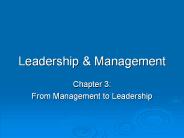Leadership - PowerPoint PPT Presentation
1 / 14
Title:
Leadership
Description:
Extroversion: assertive, sociable. Agreeableness: cooperative, warm ... Emotional stability: calm, self-confident (person's ability to withstand stress) ... – PowerPoint PPT presentation
Number of Views:70
Avg rating:3.0/5.0
Title: Leadership
1
Leadership
- Ability to influence a group toward the
achievement of goals - I) Trait Theories
- II) Behavioral Theories
- III) Contingency Theories
2
Trait Theories
- Traits can predict leadership
- Leaders born as leaders
- Personality characteristics- Big Five
- Extroversion assertive, sociable
- Agreeableness cooperative, warm
- Conscientiousness responsible, organized,
dependable, reliable - Emotional stability calm, self-confident
(persons ability to withstand stress) - Openness to experience creative, curious
3
II) Behavioral Theories
- 1) Ohio State Studies Questions were asked to
subordinates about their feelings perceptions
concerning their leaders - Initiating structure Behavior attempting to
organize work, relationships goals - Consideration Person having job relationships
characterized by mutual trust, respect for
subordinates goals regard for their feelings
4
2) University of Michigan Studies
- Product-oriented Emphasize technical task
aspects of the job - Employee-oriented Emphasize interpersonal
relationships taking personal interests in the
needs of their subordinates - gt Higher group activity higher job satisfaction
5
3) The Managerial Grid
- Two dimensions, which a leader gives importance
- (1.1) Impoverished
- (1,9) Country club
- (5,5) Middle-of-the-road
- (9.1) Task oriented
- (9,9) Team oriented
Concern for people
Concern for production
6
II) Contingency Theories
- 1) The Fiedler Model An individuals leadership
style is essential in success. LPC
(Least-preferred co-worker) questionnaire. - 16 objectives (pleasant/unpleasant,
open/guarded...) Situations - Leader-member relations
- Task structure
- Position power
- Change leader to fit the position or vice versa.
7
2) Leader-Member Exchange Theory
- Leaders establish a special relationship with a
small group of followers - gt In-group Higher performance ratings, lower
turnover intentions, greater satisfaction with
their superiors, higher overall satisfaction than
those in out-group
8
3) Path-Goal Theory
- Leaders job is to assist his/her followers in
attaining their goals goals being compatible
with organization - Leaders behavior is acceptable immediate source
of current future satisfaction Motivational - Makes subordinate need satisfaction contingent on
effective performance - Provides coaching, guidance, support rewards
necessary for effective performance
9
Environmental Contingency Factors Task
Structure Formal authority system Work group
Leader behavior Directive Supportive Participati
ve Achievement-oriented
Outcomes Performance Satisfaction
Subordinate Contingency Factors Locus of
control Experience Perceived ability
10
4)Leader-Participation
- Leadership behavior participation in decision
making are related - 7 Questions about structure, decision-making and
subordinates gt Decision Tree gt Leadership
styles (Autocratic, Supportive, Participative)
11
Inspirational Approaches to Leadership
- I) Charismatic Leadership Vision, willingness to
take risks to achieve that vision, sensitivity to
followers needs, exhibiting behaviors that are
out of ordinary - Dark Side Sometimes recklessly used
organizational resources for their personal
benefits
12
Leadership
- II) Transactional Leadership Ohio-State,
Fiedler, Path-Goal Theory- Motivate their
followers in the direction of established goals
by clarifying role task requirements - Laissez-faire Most passive, least effective
- Management by exception Ineffective, available
only when a problem occurs - Contingent reward can be effective, but will not
get employees to go beyond the call of duty
13
III) Transformational Leadership
- Encourage followers to be more innovative
creative - Idealized influence Behaving in admirable ways
that cause followers to identify with the leader - Inspirational motivation Articulating a vision
that is appealing inspiring the followers - Intellectual stimulation Taking risks,
soliciting followers ideas gt encourage
creativity in followers - Individualized consideration Attending each
followers needs
14
IV) Authentic Leadership
- Role of ethics trust
- Authentic leaders know who they are, know what
they believe in and value act on these values
and beliefs openly - Their followers consider them as ethical people































